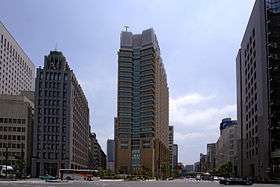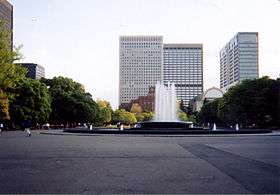Hibiya
Hibiya (日比谷) is a colloquial name for a neighborhood of Chiyoda Ward in Tokyo. The area along Hibiya Street (National Route 1) from Yūrakuchō to Uchisaiwaichō is generally considered Hibiya district. Administratively, it is part of the Yūrakuchō district.


There is no administrative district in Chiyoda called "Hibiya". Hibiya is used in some local place names such as Hibiya Park (Hibiyakoen) and Hibiya Station (administratively in Yūrakuchō). Hibiya was part of the old Kōjimachi ward in Tokyo City, before it was transformed into a metropolis.
The outskirts of this district are reclaimed from the ocean, so the name of "hibi" of Hibiya is derived from the facility for the laver of nori made of bamboo whose name is also "hibi". This effectively makes 日比谷 (Hibiya) an ateji, kanji characters used to phonetically represent native Japanese words.
History
In the era of Tokugawa shogunate, the Tokugawa bakufu worked out of Edo castle and the area surrounding Edo castle was developed and landfilled and the fishing village became an urban area where many Daimyō live.
After the end of the Meiji Restoration Hibiya, the city of Tokyo had become a modern city for there were many buildings including the Imperial Hotel (Tokyo's first western hotel), Rokumeikan, Tokyo city hall and the Tokyo Club. In the 1930s, the first Japanese electric traffic light appeared at a Hibiya crossing point. The once fashionable district has changed into a business street.
See also
- Tokyo Metro Hibiya Line, a Tokyo Metro subway line that runs through the area
- Yurakucho, an administrative district covering the entire Hibiya area
- Hibiya Godzilla Square
External links
| Wikimedia Commons has media related to Hibiya. |